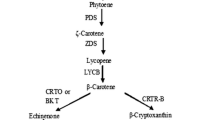Abstract
Three Gracilariopsis lemaneiformis strains, including wild type and high-temperature-resistant cultivars 981 and 2007, were studied with the changes in their photosynthetic pigment contents and related gene transcription levels under different light intensities (10, 60, 100, and 200 µmol m−2 s−1). The three G. lemaneiformis strains had the following photosynthetic pigments with high-to-low contents: phycoerythrin (PE), phycocyanin (PC), allophycocyanin (APC), and chlorophyll a (Chl a). Among the three strains, cultivar 981 had the highest PE content, followed by cultivar 2007. The PC and APC contents were similar among the three strains, but they were higher in cultivars 981 and 2007 than in the wild type. The Chl a contents in the three G. lemaneiformis strains were equal. A low light intensity (10 µmol m−2 s−1) promoted photosynthetic pigment accumulation in G. lemaneiformis and improved the relative PE gene transcription (peA and peB) in a short period (≤ 6 d). A high light intensity decreased the PE content. PebA and PebB, which catalyzed phycoerythrobilin synthesis, showed no compensatory upregulation at a low light intensity among the strains except for the wild type. At a high light intensity, transcription levels of pebA and pebB in the three strains were upregulated. This study provided an experimental basis for elucidating the photosynthesis of G. lemaneiformis. As key genes of algal growth, photosynthesis-related genes served as useful gene markers for screening elite varieties with good traits in breeding. Cultivar 2007 was superior to cultivar 981 in terms of maintaining high pigment levels in a wide range of light intensities, which is the most suitable for aquaculture.
Similar content being viewed by others
References
Ak, I., and Yücesan, M., 2012. Effect of light intensity on the pigment composition of Gracilaria verrucosa (Rhodophyta). Fresenius Environmental Bulletin, 21: 2126–2131.
Chen, W. Z., Di, X. U., Wang, L. G., Meng, L., Hong, D. U., and Zhang, X. C., 2009. Preliminary study on economic characteristics and agar characteristics of two new strains of Gracilaria lemaneiformis. Periodical of Ocean University of China, 39(3): 437–442 (in Chinese with English abstract).
Dammeyer, T., and Frankenbergdinkel, N., 2006. Insights into phycoerythrobilin biosynthesis point toward metabolic channeling. Journal of Biological Chemistry, 281: 27081–27089.
Ficner, R., Lobeck, K., Schmidt, G., and Huber, R., 1992. Isolation, crystallization, crystal structure analysis and refinement of B-phycoerythrin from the red alga Porphyridium sordidum at 2.2 A resolution. Journal of Molecular Biology, 228: 935–950.
Freile-Pelegrín, Y., and Murano, E., 2005. Agars from three species of Gracilaria (Rhodophyta) from Yucatán Peninsula. Bioresource Technology, 96: 295–302.
Gantt, E., 1980. Structure and function of phycobilisomes: Light harvesting pigment complexes in red and blue-green algae. International Review of Cytology, 66: 45–80.
Grossman, A. R., Schaefer, M. R., Chiang, G. G., and Collier, J. L., 1993. The phycobilisome, a light-harvesting complex responsive to environmental conditions. Microbiological Reviews, 57: 725.
Haldrup, A., Jensen, P. E., Lunde, C., and Scheller, H. V., 2001. Balance of power: A view of the mechanism of photosynthetic state transitions. Trends in Plant Science, 6: 301–305.
Huang, X., Zang, X., Wu, F., Jin, Y., Wang, H., Liu, C., Ding, Y., He, B., Xiao, D., and Song, X., 2017. Transcriptome sequencing of Gracilariopsis lemaneiformis to analyze the genes related to optically active phycoerythrin synthesis. PLoS One, 12: e0170855.
Kursar, T. A., Van, D. M. J., and Alberte, R. S., 1983. Light-harvesting system of the red alga Gracilaria tikvahiae: II. Phycobilisome characteristics of pigment mutants. Plant Physiology, 73: 361–369.
Livak, K. J., and Schmittgen, T. D., 2001. Analysis of relative gene expression data using real-time quantitative PCR and the 2(-Delta Delta C(T)) Method. Methods, 25: 402–408.
Maccoll, R., 1998. Cyanobacterial phycobilisomes. Journal of Structural Biology, 124: 311.
Maccoll, R., and Guard-Friar, D., 1987. Phycobiliproteins. CRC Press Inc., Boca Raton, 218pp.
Marinho-Soriano, E., 2012. Effect of depth on growth and pigment contents of the macroalgae Gracilaria bursa-pastoris. Revista Brasileira De Farmacognosia, 22: 730–735.
Meng, L., Xu, D., Chen, W. Z., and Zhang, X. C., 2009. Selection and characterization of a new strain of Gracilaria lemaneiformis. Periodical of Ocean University of China, 39(S1): 94–98 (in Chinese with English abstract).
Rochaix, J. D., 2007. Role of thylakoid protein kinases in photosynthetic acclimation. FEBS Letters, 581: 2768–2775.
Sommers, E., 2013. A Look Into the Past: Photo-Physiology of Cyanobacterial Mat Pigments in Alpena, Michigan and Lake Huron Sinkholes. Presentation, Annis Water Resource Institute (AWRI).
Talarico, L., and Maranzana, G., 2000. Light and adaptive responses in red macroalgae: An overview 1. Journal of Photochemistry & Photobiology B Biology, 56: 1–11.
Wu, F., Zang, X., Zhang, X., Zhang, R., Huang, X., Hou, L., Jiang, M., Liu, C., and Pang, C., 2016. Molecular cloning of cpcU and heterodimeric bilin lyase activity analysis of CpcU and CpcS for attachment of phycocyanobilin to Cys-82 on the β-subunit of phycocyanin in Arthrospira platensis FACHB314. Molecules, 21: 357.
Zhang, Y., Feng, Y., Feng, Z., and Cao, K., 2003. Morphological and physiological acclimation to growth light intensities in Pometia tomentosa. Acta Photophysiologica Sinica, 29: 206–214.
Acknowledgements
This research was supported by the National Natural Science Foundation of China (No. 31872555), the China Agriculture Research System (No. CARS-50), and the Key Program of Science and Technology Innovation Ningbo (No. 2019B10009). Critical comments and support were provided by Dr. John van der Meer.
Author information
Authors and Affiliations
Corresponding author
Rights and permissions
About this article
Cite this article
Cao, X., Wang, H., Zang, X. et al. Changes in the Photosynthetic Pigment Contents and Transcription Levels of Phycoerythrin-Related Genes in Three Gracilariopsis lemaneiformis Strains Under Different Light Intensities. J. Ocean Univ. China 20, 661–668 (2021). https://doi.org/10.1007/s11802-021-4616-4
Received:
Revised:
Accepted:
Published:
Issue Date:
DOI: https://doi.org/10.1007/s11802-021-4616-4




